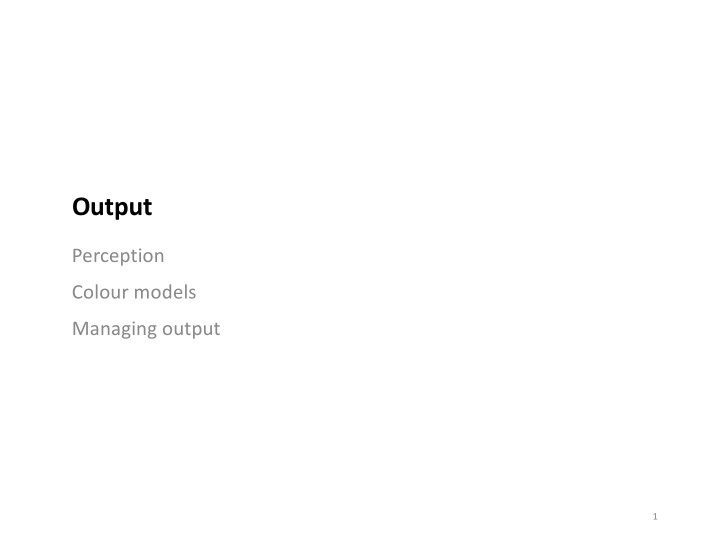



Output Perception Colour models Managing output 1
Human Elements of Graphical Output Psychophysics: “out there” vs. “in here” Relationship between external stimuli and internal sensations § Temporal and spatial resolution § Vision and color perception § Interpretation of visual elements perceive present 2
Temporal Resolution: Flicker § Critical Flicker Frequency (CFF) - when perception of intermittent light source changes from flickering to continuous light - dependent on brightness of stimulus, wavelength, others … ~ 45 Hz brighter stimulus Image: http://webvision.med.utah.edu 3
Temporal Resolution: Flicker into Motion § CFF can also create perception of continuous motion - 24 FPS film, 60 FPS NTSC video, HFR video 120 FPS -> motion effect - motion blur required to make scenes look “real” Image: http://webvision.med.utah.edu 4
Zoetrope, mechanical example of CFF - https://youtu.be/-hE_fA9M580?t=5s 5
Spatial Resolution: Visual Acuity § spatial resolution of visual processing system - 20/20 (6/6) vision: separate lines 1 arc minute (1/60°) apart at 20 feet (6 m) 1/60 ゜ 6m 6
Spatial Resolution Implications § Best pixel density for displays? - density is measured in ppcm (pixels per cm) or dpi (dots per inch) 1/60 ゜ y y = 0.116mm (at .4m), y = 0.203mm (at .7m) We can see individual pixels no smaller than about 0.116 to 0.203 mm 7
“Retina” Displays § iPhone X “Super Retina” - Screen: 2436 by 1125 px - Distance: 10 to 12 inches away - Perceptible: 457 ppi, pixel size 0.056mm - Actual: 462 ppi § 15 inch MacBook “Retina” - Screen: 2800 by 1800 px - Distance: 20 to 24 inches away - Perceptible: 221 ppi, pixel size 0.12 mm - Actual: 221 pixels per inch 8
Visible Colour Spectrum § Wavelength determines colour (in nanometres, nm) - Ultraviolet (UV) < Visible < Infrared (IR) -- near IR used for input ~850nm § Combined wavelengths - example: orange is around 600 – 620 nm, but “orange light” can be brighter/darker when other wavelengths added 9
Colour Perception § Two different light sensors in human eye - Cones perceive colour (and help focus) - Rods distinguish light from dark (and contribute to peripheral vision) § cones and rods not evenly distributed - spatial resolution of visual field drops significantly at edges Image: www.webexhibits.org 10
Rod and Cone Color Sensitivity Image Credit: Fleet 11
3 Types of Cones means Trichromatic Vision - Blue, green, and “red” cones (almost yellow) - Variations in stimulation lead to sensing of different colors - Few blue cones (but rods sense blue too) - Harder to notice blues than reds Actual Cone Response (Johnson, page 38) 12
Humans, Birds, and Bees Visible Light UV Light Image: http://fieldguidetohummingbirds.wordpress.com 13 http://www.naturfotograf.com/UV_flowers_list.html#top/
Colour Blindness § monochromacity: 2 or 3 types of cones missing § dichromacy: 1 type of cone missing - Protanopia: missing red cones (~1% of males) - Deuteranopia: missing green cones (~1% of males) - Tritanopia: missing blue cones, (and blue sensitive rods) (rare) protanopia deuteranopia tritanopia 14
For Color Blindness Just… don’t do this. CS349 -- Accessibility 15
What color is the dress? http://www.wired.com/2015/02/science-one-agrees-color-dress/ 16 https://en.wikipedia.org/wiki/The_dress
Beau Lotto, Optical illusions show how we see (Ted 2009) - https://www.ted.com/talks/beau_lotto_optical_illusions_show_how_we_see#t-461256 17
Design Implications: Contrast, not Brightness § We are more sensitive to differences in colour and brightness, than absolute brightness levels. http://www.psy.ritsumei.ac.jp/~akitaoka/ECVP2005b.html 18
Design Implications: Colour Presentation Matters § Our ability to discriminate colours depends on presentation § Example: it’s harder to tell two colours apart when - the colours are pale - the object is small or thin - the colour patches are far apart (Johnson, page 41) 19
Representing Images and Colour 20
XKCD Colour Survey Results 21
Colour Models § Additive § Subtractive - coloured light (i.e. emitted light) - coloured light is absorbed (by is added to produce white colored material) to produce black § RGB for displays (emit light) § CMY/CMYK – printing (colored ink is blended on a surface) § HSV/HSB to describe colour 22
HSV/HSB Color Model (Additive) § Hue : determines color (approximation of wavelength) § Saturation : how much hue: e.g. red vs. pink vs. white § Value/Brightness : how much light is reflected 23
Value/Brightness vs. Saturation § Value/Brightness § Saturation - Reflecting less to more light - Containing less to more hue (gray to red, green, or blue) (black to white) Fixed saturation, Fixed value/brightness, changing saturation changing value/brightness 24
LCD Displays 25
Display Technologies § Common idea - Each pixel is actually 3 RGB sub-pixels: red, green and blue - Pack subpixels very close together so they seem to be co-located - Vary amounts of red, green, blue to excite cones in eyes 26
How to see your monitor subpixels - https://youtu.be/_O66qHq1YS4 27
Colour Harmony Complementary Analagous Triad High contrast, “opposing” Harmonious, ”pleasing” Balanced, “vibrant” http://www.tigercolor.com/color-lab/color-theory/color-harmonies.htm 28
Adobe Colour Tool - https://color.adobe.com 29
Recommend
More recommend